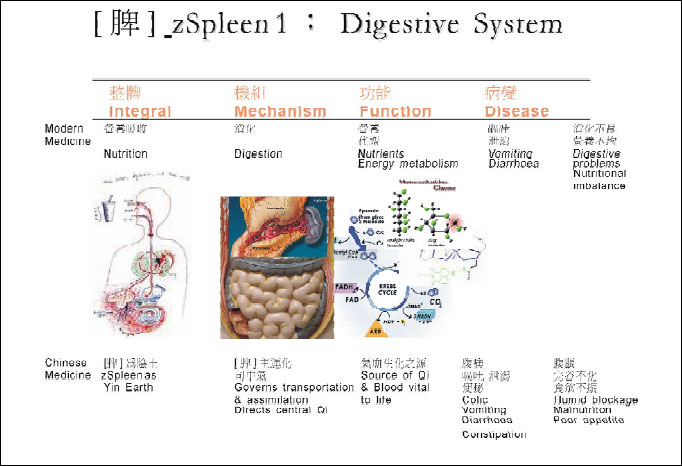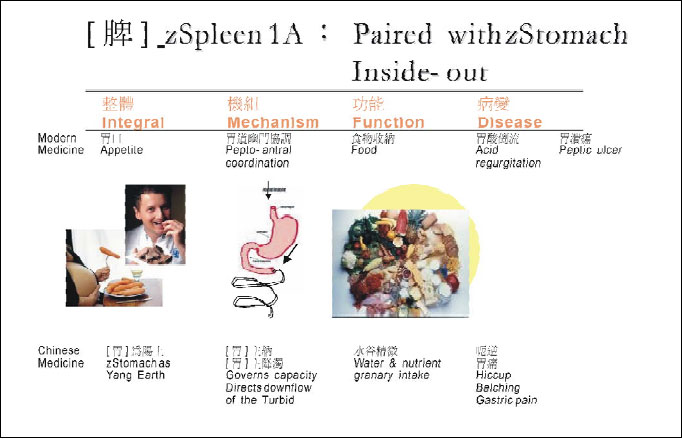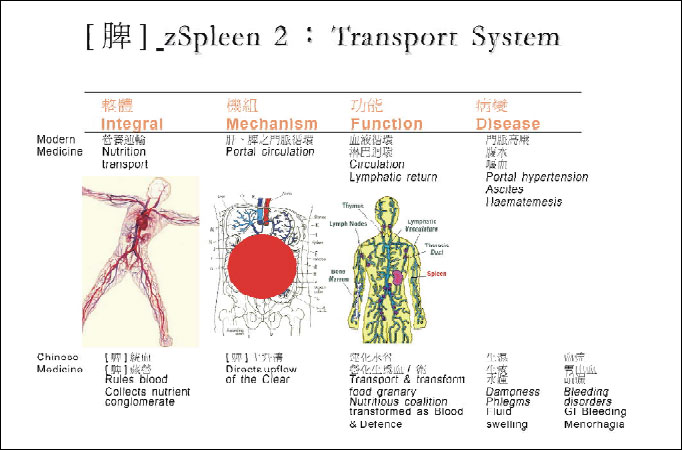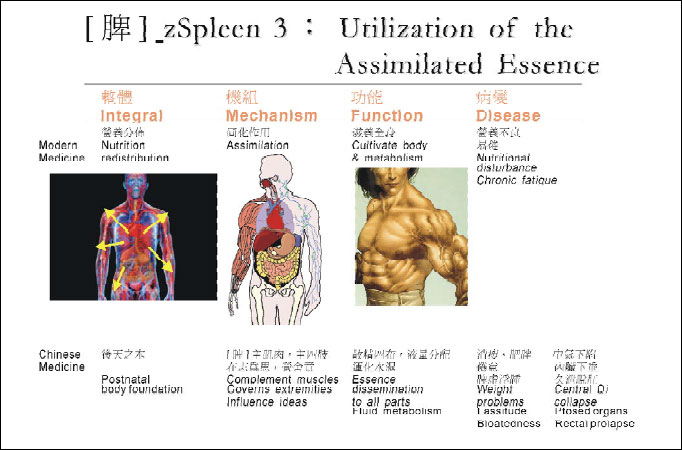
|
June 2009, Volume 31, No. 2
|
Discussion Paper
|
Understanding Traditional Chinese Medicine organs in the context of modern medicine - PART 3: Zang SpleenEdwin C L Yu 余秋良 HK Pract 2009;31:64-78 Summary This paper describes the organs of Traditional Chinese Medicine on a platform that they can be understood by workers in scientific medicine. The Zang Spleen is discussed as the same anatomical organ but with added dimensions. Formalizing modern views from the Zangfu manifestation theory of Chinese medicine, it may embrace nutrient intake and processing functions, and immunological, lympho¬circulatory, vegetative and energy balance. The view coupling immunity and intestinal functions may have significant clinical significance in diagnosis and therapy including dermatitis. 摘要 本文以現代醫學角度陳述中醫學的臟腑 —脾臟。在此對中醫脾臟將以慣常了解的解剖學器官及其附加元素討論。按中醫學臟象理論, 現代觀念中的脾臟可包括食物攝取及處理功能,和免疫、淋巴循環、營養及能量的平衡。這個結合免疫和腸胃功能的觀念, 有助臨床上的診斷和治療,其中也包括皮膚疾患。 * Note : This is the 3rd of a series of articles on TCM organs Introduction Zang organs 臟 in traditional Chinese medicine (TCM) depict solid organs which collect and store, and are described as a set of interrelated parts rather than a single anatomical organ. The Zangfu manifestation theory臟象學說 expresses the Zang organs as organ networks by generalization from physiological and pathological manifestations of the body systems. Readers of my two previous articles on Zang Kidney and Zang Heart1,2 might consider TCM to be simple. Plain words were used to take readers off the burden of TCM words that are difficult to understand. TCM is certainly more complex and the previous articles only described one perspective of looking at the Zang organ (zOrgan), a perspective made simplistic to meet modern science. That perspective has been advanced by the belief that our ancestors started with essentially the same anatomical organ but with a wider dimension, and by using the platform expanded with an integral view additional to the usual mechanistic and functional view of current science. This approach coupled with recognizing framework blind spots left by history from modern medicine and Chinese medicine, had allowed identification of the added dimension to the named anatomical organ to match each zOrgan in structural terms. Ancient scholars might have added ascribed functions throughout the centuries to that structural complex. Thus, functions of zOrgans have been explained by functions inherent with the structure and with the internal interactive mechanisms supporting the structural complex,3 so as to be compatible with TCM's external manifestations (termed Zang Xiang 臟象). These steps to identify that structural complex may well be successful with zHeart and zKidney. Although simplistic, it is nevertheless useful in helping readers in comprehending most of the ascribed Zang functions TCM described. However, not all zOrgans can be made simplistic. The Zang Spleen (zSpleen), by its central position in TCM Zang theory, has probably more extraneous functions and is more complicated. In TCM, the zSpleen's major function has been understood to be digestive. This is of course far from the splenic function in modern science. Defence and Immunity Most of orthodox TCM texts do not address this area when referring to zSpleen. The anatomical spleen is a lymphopoeitic organ. Before the immune system was elaborately defined in Western medicine, the spleen was linked with the liver and intestines by the portal circulation. It is now known to be an important organ in blood and immune disorders. Embryologically the spleen is a circulatory component, being filled later and expanded with influx of immune cells. The immune system, composed of cells and molecules, has an innate and an adaptive response. The innate immune response, comprising natural killer cells, mast cells, dendritic cells, phagocytes, cytokines, complements, and acute phase proteins, represents the first line of defence to intruding pathogens. It is non¬specific, without memory, and respond to substances which the body regards as foreign or potentially harmful. The adaptive immune response, comprising T and B cells, cytokines and antibodies, display a high degree of memory and specificity, and can evoke a more potent response on second exposure to the pathogen. The adaptive immune response frequently incorporates cells and molecules of the innate response in its fight against harmful pathogens.4,5 The immune cells mentioned above form a system of defence. Only a few cells of each specificity are stored as template for mass production at times of antigen stimulation. Each episode of stimulation contributes to the concept of "self".6 The lymphatic system and the circulatory system helps to circulate these immune cells, allows regulation and clearance of foreign materials, and promote confrontation against foreign pathogens. Three major sites of external confrontation exist, which are the skin surface, the lung epithelium, and the intestinal mucosa. Ying營 and Defence Defence has been understood as a necessary concept in any heritage or lineage of medicine. In TCM, defence has evolved slowly as theory needed to be backed up with experience in practice. The system was much refined with significant clinical applications in the Ching dynasty. Defence was described in layers or cores, with a first outer defence, followed by defensive Qi energy, backed up by coalition defences and blood 衛氣營血 (Wei, Qi, Ying, Zue).7 Short of the cellular theory, each of the defence cores consists of a textural interplay of many TCM based elements. Ying and Wei have been described early since Huangdi Neijing: "Ying is the essence of nutrient granary..... Wei is the defence with nutrient granary".營者,水谷之精氣也 ....衛者,水谷之悍氣 .8 Here, Ying 營 (buildup, battalion) is translated as "coalition". Currently the very early TCM concept of Ying 營 has been refined. Now, Ying, the nutritious coalition, is the coalition battalion formed from absorbed food essence. The coalition forms a defence texture circulating in the blood throughout the body, while the Wei Defence move along with it externally to traverse among tissues營行脈中,衛行脈外 . Wei may be analogous to the immune cells, and Ying Qi becomes one Qi energy of defence and resources in the circulation. The Zang Spleen
The understanding of zSpleen in TCM reads,9
In short, the zSpleen-Stomach organ complex refers to gastrointestinal functions and the extension of its influence. With the belief that our ancestors started with essentially the same anatomical organ but with a wider dimension, there has been much discussion that the ancient spleen actually refers to the spleen-pancreas,10,11 best quoted early in Nanjing12 as: "the spleen weighs two jin and three liang, is three cun wide and five cun long, and has a half jin of clustered fatty tissue 脾重二斤三兩,扁廣三寸,長五寸,有散膏半斤 ". That fatty tissue certainly meant the pancreas. The modern view believes that the zSpleen involves at least the digestive system, its vegetative nervous system, immunological system, hemopoiesis, muscle metabolism, energy and water metabolism. All these can be understood more easily by putting them comprehensively in the integral-mechanistic¬functional platform illustrated here. The functions of the zSpleen will be described separately under the digestive system (Figure 1) and when paired with the zStomach (Figure 2), the transport system (Figure 3) and utilization of the assimilated essence (Figure 4).
1.Digestion system The integral body needs nutrition. Through digestion, nutrients from food are assimilated to support all metabolism. In TCM, the zSpleen transforms food and drink into essence and transports them around the body. The zSpleen is taken as Yin Earth [脾]為陰土 according to the 5-element theory, since Earth is the source of resources. In fact, all zOrgans are Yin organs because they collect, store, make and transform substances. The zSpleen is essential to digestion, acting as the source of Qi and blood, and serves as the origin of all metabolism vital to life氣血生化之源. 2.Paired with zStomach The zSpleen and zStomach are inside-out related相表裏 and connected by the Meridians. Neijing described the zSpleen(-pancreas) and stomach as connected by a membrane.13 While zSpleen governs transportation and transformation, zStomach governs the accepting capacity [脾]主運化,[胃]司受納.14 As the zStomach accepts and acts as a reservoir, it prepares for the zSpleen in transportation and transformation. Reciprocally, as the zSpleen governs transportation, it adapts the zStomach for capacity for food intake. The two are inter-regulated by physical, neural, and endocrinal signals. Motilin is released from M cells of the duodenum and jejunum into the blood during fasting or interdigestive period to improve peristalsis in the small intestine, helping to clear out the gut in preparation for the next meal.15 This 22 amino acids hormone is structurally related to ghrelin, which is secreted by the stomach and regulates gastric function through limiting food intake by increasing satiety and affecting energy homeostasis.16,17 Other mediators of satiety including glucagon like peptide-1 (GLP-1) are mainly produced by intestinal L cells. PeptideYY3-36 which is released in response to a meal,18 reduces appetite and inhibits gastric motility, thereby increasing efficiency of digestion and nutrient absorption after a meal. Peptide YY neurons may also play a coordinating role through visceral, motor, and sympathetic output targets.19 Cannabinoid receptors present in neurons and endocannabinoids synthesized in the gastrointestinal tract are modulated by feeding. They are responsive to nutritional status, and influence several important aspects of nutrient processing, including gastric secretion, gastric emptying, and intestinal motility.20 3.As transport system Food essence needs to be transported to all parts of the body [脾]主為胃行其津液者也 .21 Food nutrients extracted into jBlood rise up through the portal circulation. TCM described two ways that the zSpleen transports water and essential nutrients around the body: by essence dissemination and by nutrient redistribution. One part predominantly flows upwards to the lung and is rapidly dissemmated to the whole body. This ascending movement is believed to be directed by the zSpleen through the Spleen Qi. TCM emphasizes the upflow and downflow movements like cycling currents for body turnover balance. The so-called "raising the clear"[脾]主升清 refers to its upflow and distribution of the essence. Another part, the nutrients, passes through the liver for metabolism and is thereafter distributed to the whole body. To give some analogous comparison, transport of lipids into the circulation is different from sugars and amino acids. Sugars and amino acids, like most nutrients, are absorbed directly into capillary blood through the portal circulation and hepatic metabolism. Chylomicrons, carrying lipid, does not enter the liver but are transported first into the lymphatic vessel in the intestinal villi. Chylomicron-rich lymph then drains into the systemic lymphatic system, via the blood and finally to the tissues throughout the body for utilization. While transporting nutrients, the zSpleen also distributes fluid, thus simultaneously nourishing and moistening every tissue of the body. In general, the whole process of water distribution and metabolism is jointly accomplished by the zLung (through its dispersing and descending functions) and the zSpleen (through transportation and transformation functions) so that water is sent down to the kidneys and excreted from the urinary bladder. This zSpleen forward regulatory function in water metabolism helps to prevent fluid from becoming stagnant, coined "Dampness recycling"運化水濕. Through this function, excess fluid can be removed. The zSpleen's upflow and zStomach's downflow are complementary. The zSpleen directs upflow of the essence, while the zStomach directs downflow of the turbid (the disposal residue) to the large intestine or the bladder. This dynamic circulation also influences the dynamic distribution of Qi energy and blood as the nutritious coalition is collected by the zSpleen [脾]藏營 .22 The zSpleen also functions to prevent extravasation of blood and nutrients. TCM views that the zSpleen governs jBlood [脾]統血 by its Ying and Wei mechanisms. That vitamin C deficiency bleeds and platelets heal are part of these mechanisms. 4.Utilization of the assimilated essence As the zSpleen is the source of Qi and all metabolism vital to life, the postnatal body foundation 後天之本, or powerhouse after birth, is also provided by the zSpleen. All parts of the body nourishment are cultivated through its functions. The zSpleen complements with muscles [脾]在體合肉. The normal vitality and movements of the four limbs requires nourishment for the muscles, and in turn are related to Spleen Qi [脾]主四肢 by its distribution of ample nutrient substances. The zSpleen influences idea formation [脾]在志為思 23 which can be understood as the nutritious conglomerate 營 of nutrients with a variety of composition arriving at the brain, each variety promoting ideas[脾]藏營,營舍意 .22 Dietary tryptophan affects brain serotonin,24 essential oils are essential for the brain, and chocolates stimulate joy are examples. Food incompatibility and allergy The digestive and assimilative function of the upper gastrointestinal tract conforms well with the TCM ascribed functions. Conceptually, the zSpleen-Stomach theory is a comprehensive one. Why was an zOrgan of digestion categorized in TCM under a remotely related "spleen"? Many may try to take it as a misnomer, since it may have been confused with the pancreas. To add more justification, the word脾胃 has also been understood even in lay usage for the gastrointestinal function. However, even the Nanjing passage included a description of the spleen. Being open in mind may let one be better inspired.25,26 Let us for a start review the histology of the small intestine. There are a lot of Peyer's patches which are lymphopoietic follicles under M-cells (Membranous or 'Microfold' cells) scattered between the enterocytes that work for transportation. It can be easily understood as the intestine is one of the three major sites of the body confronting external pathogens. In fact, there are much more immunity events going on here than other body parts because of the much larger quantity of pathogens to handle. After all, while the body takes in external substances for the benefit of nutrition, the body also faces things foreign not being tolerated. How this dilemma is handled by the body is better understood by looking at the coupling of immunity and intestinal function since its fetal development. Before birth, while its absorptive function is ready, the immunity apparatus of the intestine is still immature. For example, the lymphopoietic function of Peyer's patches have not yet developed. At birth, intestinal absorption gradually assumes full function, while many more changes occur in the immunity apparatus: increase in primary at-site lymphopoiesis with germinal centers, and maturation of immunoglobulin specificity. In fact, polyclonal TCR b-chain production becomes more oligoclonal and specific only after enteral feeds and microbial colonization.25 It is clear that the intestinal mucosa, apart from absorption, is a primary host defence and recognition organ. Thus a substance entering the intestinal tract can be considered either as a nutrient or a pathogen. If this "substance" is not properly handled, abnormal bowel responses to food including food allergy can occur. In TCM, infants are considered to have an inadequate zSpleen function. Interestingly, bowel function disturbances are particularly common at that age. When older, rampant style of eating junk food for joy rather than for health can also cause problems. The ancient Ying 營 and Wei 衛 describes the coupling of nutritious coalition as battalion and defence traversing tissues. Recent knowledge shows what our ancestors recognized intuitively through their integral approach: that the human bowel is the primary site of absorption and molecular defences against disease. Thus the whole spleen-pancreas and gastrointestinal tract can be taken as one apparatus coupling absorption, recognition of foreign materials and tolerance of registered foodstuff and microflora. Emphasizing nature and associated meaning of things, TCM tried to view the body anatomy not only as a single organ but also with its structural function and working mechanism related to other organs. The Zangfu manifestation (Zang Xiang) theory stated "the Zang-fu organs situated internally are manifested externally (physiological and pathological manifestations reflected externally), thus called Zang Xiang" 臟居於內,形見於外,故曰臟象 .25 Now with the spleen-pancreas-gastrointestinal apparatus as the zOrgan inside, the intrinsic functions, the higher interactive mechanisms and its domain of influence can be seen as external manifestations or Zang Xiang. Modern understanding of the zSpleen embraces intestinal functions, immunological functions, nutrient-related functions over muscles and circulation, and its regulatory part of the neuro-endocrine system.10 The zSpleen is taken as a mastery organization of energy and water metabolism. Disease and pathophysiology (Figures 1-4) TCM pathophysiology sees the zSpleen divide into Spleen Yin (its material and structures), Spleen Yang (its intrinsic energy and reserve), and Spleen Qi (its propulsive and energy functions). Most of the zSpleen disorders can be understood by the upflow, circulating, and disseminating 升動散 actions of the Spleen Qi, as supported by the Spleen Yang. Generally, when the zSpleen is functioning well, digestion will be good, muscles strong and circulation efficient. When its function is weak, there may be nausea, cold hands and feet, lack of muscle tone, easy bruising or poor concentration. In zSpleen deficiency, the diagnostic criteria in common are poor appetite, abdominal fullness after meal, loose bowel movements, and pale or sallow complexion. The characteristic symptoms are fatigue, asthenia, wasted muscles, pale tongue with thin white coating and a moderate pulse which is often also weak. Deficiency disorders include Spleen Qi deficiency, Spleen Yang deficiency, Spleen-Stomach Yin deficiency, collapse of Spleen Qi脾氣下陷, and zSpleen not governing circulation 脾不統血. Spleen-Yang deficiency will have added cold limbs, and fear of cold, while Spleen-Stomach-Yin deficiency will have general wasting, a dry mouth and lips with a shrunken smooth and bare, red tongue. Collapse of central or zSpleen Qi means loss of skeletal and smooth muscle tone, with down bearing of organs, flaccidity, vertigo and blurred vision. Easy bleeding and bruises are referred to as zSpleen not governing circulation. Chronic dysfunction of the gastrointestinal tract alone is better understood under stagnate bowels 積滯, resulting from prolonged overburden by untolerated food, well described in children and associated with zSpleen deficiency. Its main symptoms are poor appetite, food undigested, abdominal distention, wasting, passing particularly foul smelling constipated or loose stools. Disharmony of the Stomach Qi is characterized by epigastric fullness, poor appetite, gastric pain. Upward reverse flow of the Stomach Qi is characterized by nausea, vomiting, belching and hiccup. Pathological states of zStomach's acceptance as well as zSpleen's transportation and transformation should be differentiated. Loss of appetite or epigastric upset with rapid hunger is attributable to zStomach diseases, and treatment aims to increase the appetite and harmonize the zStomach. Indigestion, abdominal distension after meals and loose stools are attributable to zSpleen diseases, and treatment aims to strengthen the zSpleen to help its transportation. Failure to transport and transform Qi and nutrient substances will cause malnourishment of the muscles characterized by muscle wasting, weakness of the four limbs, and even flaccidity. At its worst, Spleen or Central Qi collapse may occur with down bearing and distending sensation in the abdomen, vertigo, blurred vision, chronic diarrhoea, rectal or internal visceral prolapse. TCM emphasizes on the balance of upflow and downflow cycling movements. The failure of the clear Qi of zSpleen to flow upwards will impair the downward flow of the turbid Qi, and vice versa. These affect the motility, secretory, assimilative, absorptive and dispersing functions of the digestive tract, as well as the functional activities of the vegetative nervous system of the gut and gut hormones, thereby affecting functioning of other organs. The syndrome of zSpleen deficiency can be a multi¬system and multi-organ functional impairment. The zSpleen is weakened by Dampness濕 (wet, humid, damp), best understood as a decreased ability to adapt to humid environment. If the zSpleen fails in its transportation and transformation function, excess water accumulates inside the body. Retained in the skin and muscles, it may manifest as swelling or bloatedness. If retained in the intestines, it will cause diarrhoea, while in the abdominal cavity, ascites. In the Suwen it says, "...various kinds of diseases caused by dampness with swelling and fullness belong to the Spleen"諸濕腫滿皆屬於[脾] .26 Locked in channels and vessels, the fluid may be associated with waste metabolites as an inflammatory material 痰 (mucus, phlegm), causing chronic inflammation and degeneration. Together with good supply of nutrients and immunological competency, the zSpleen regulates and keeps blood circulating inside the blood vessels. Qi deficiency of zSpleen may lead to loss of control and blood flows outside from vessels, with various haemorrhagic symptoms and diseases, such as chronic uterine bleeding. Before leaving this discussion on zSpleen deficiency syndrome, one closely related syndrome, Damp-heat濕熱 must be described. Essentially, they are two body pathologies, the Damp syndrome濕 and the Heat syndrome 熱 concurring and interacting together. These, unlike other syndrome types which come together sporadically, occur together and are often very closely related. Dermatitis and eczema, called wet-rash 濕疹 is related to dampness interlocked with heat 濕熱. Hepatitis and urinary tract infection are also affected by Damp-heat. In dermatitis patients, swelling and bloatedness of varying degrees are common even in non-affected areas, suggesting lymphedema which are often underdiagnosed. It is therefore clear that the zSpleen is a central coupling to problems of the intestines, lymphatics, and immunity, while Western medicine may have thought them to be discrete entities. Furthermore, zSpleen deserves more than just to be considered as intestines in TCM. Confronting with modern medicine The above description of zSpleen and disorders brings TCM closer to modern science. Salivary alpha-analysis, a measure of endogenous adrenergic activity, can be a good marker of zSpleen deficiency27 particulary after acid stimulation. Bloatedness is quite common. It is sometimes severe and appears similar to gross oedema. Diuretics usage may not be needed, since it is quite ameliorable with therapy that improves body quality and rid body of bloatedness by its better circulatory and lymphatic forces. However, in Western medicine, its significance is much downplayed as only oedema is recognized. The traditional view that lymphatic capillaries are passive channels need to be challenged.28 Does understanding zSpleen help treating gastrointestinal diseases? Decrease in xylose excretion, a measure of intestinal absorption in chronic atrophic gastritis patients with zSpleen deficiency syndrome improves after fortifying treatment. It is clear that many other gastrointestinal diseases need conceptual breakthroughs. Nevertheless, TCM treatment of such diseases are often remedial and not just symptomatic. Understanding the TCM zSpleen in dealing with gastrointestinal problems offers many more modalities for rectifying its disorders. Stagnate bowel with its chronic gastrointestinal dysfunction is not uncommon even in adults and treatment along such concept helps the bowel in regaining its intrinsic motility and absorptive functions. The zSpleen-stomach principles applied in the treatment of irritable bowels are particularly useful. As mentioned above, zSpleen deficiency is a systemic disorder, and dysfunction of vegetative nervous system at the gastrointestinal tract coexists. For example, the majority of zSplenic deficient patients with chronic diarrhoea and peptic ulcer have an overactive parasympathetic nervous system. Through balancing the upflow and downflow cycling movements the functional activities of vegetative nervous system can be restored and help other multi-organ disturbances. Readers are encouraged to learn more about zSpleen disorders. In body energy reduced or immunological depressed states with gastrointestinal upset, zSpleen deficiency may be observed in 60-70% of cases. zSpleen treatment will lead to improvement in up to 80%.10 Such disorders include peptic ulcers, chronic gastritis, chronic diarrhoea, ptosed organs including uterine prolapse, immunological deficiency, and atrophic muscular disorders including myasthenic syndromes. Key messages
Conclusion While the intestine had previously been thought to be mainly involved with digesting and absorbing food nutrients, it is now known that its mucosal epithelial barrier against pathogens and immunological sensing and recognition to tolerate intestinal flora are equally important. Western medicine once viewed them as discrete. The TCM perspective of zSpleen as one apparatus, coupling immunity and intestinal functions together with clinical significance could enrich Western medicine. This is particularly interesting for the understanding of treatment of dermatitis and chronic inflammatory disorders.
Edwin C L Yu, MRCP (UK), FRCP (Glasg), FHKAM (Medicine), RegCMP
Honorary Professor, School of Chinese Medicine, Hong Kong Baptist University. Correspondence to :Dr Edwin C L Yu, c/o INTEMED H.K., Room 1902-03, Chung Kiu Commercial Building, 47-51 Shantung Street, Mongkok, Kowloon, Hong Kong SAR.
References
|
|



